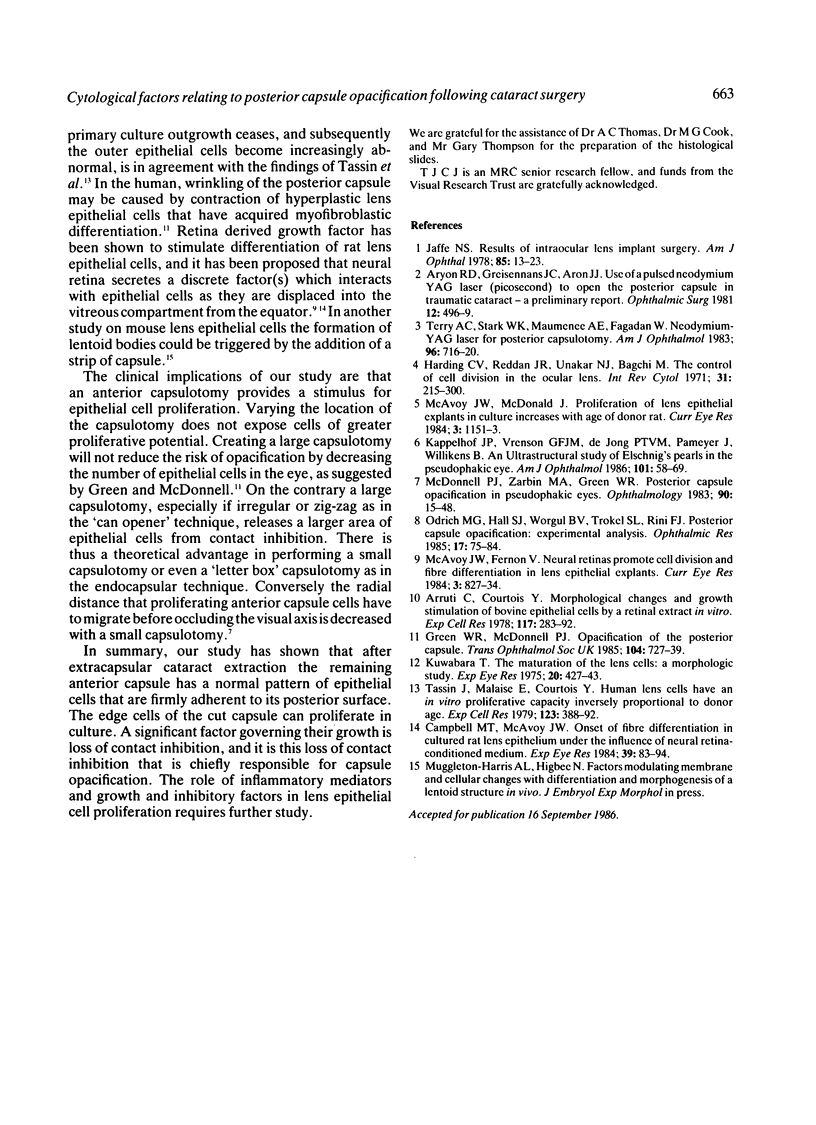Abstract
Simulated extracapsular cataract extractions on cadaver eyes were performed which demonstrated that the cells of the anterior capsule remain largely intact and that only a small amount of cortical lens matter remains postoperatively. Human lens epithelial cells from normal and cataractous lenses were grown in culture. There was no appreciable difference in growth rate between cells from normal and those from cataractous lenses or between equatorial and central capsule cells. The cells grew from the cut edges of the capsule, suggesting that release from contact inhibition is an important factor in stimulating proliferation. The daughter cells became increasingly abnormal and metaplastic in successive generations, but there was no evidence of differentiation into fibroblasts within the 35-day culture period, suggesting that a retinal growth factor may be involved with the fibrosis occurring in opacification of the posterior capsule. A small anterior capsulotomy will release fewer cells from contact inhibition and hence reduce cell proliferation after extracapsular cataract extraction.
Full text
PDF




Images in this article
Selected References
These references are in PubMed. This may not be the complete list of references from this article.
- Aron-Rosa D., Griesemann J. C., Aron J. J. Use of a pulsed neodymium Yag laser (picosecond) to open the posterior lens capsule in traumatic cataract: a preliminary report. Ophthalmic Surg. 1981 Jul;12(7):496–499. [PubMed] [Google Scholar]
- Arruti C., Courtois Y. Morphological changes and growth stimulation of bovine epithelial lens cells by a retinal extract in vitro. Exp Cell Res. 1978 Dec;117(2):283–292. doi: 10.1016/0014-4827(78)90142-8. [DOI] [PubMed] [Google Scholar]
- Campbell M. T., McAvoy J. W. Onset of fibre differentiation in cultured rat lens epithelium under the influence of neural retina-conditioned medium. Exp Eye Res. 1984 Jul;39(1):83–94. doi: 10.1016/0014-4835(84)90117-9. [DOI] [PubMed] [Google Scholar]
- Green W. R., McDonnell P. J. Opacification of the posterior capsule. Trans Ophthalmol Soc U K. 1985;104(Pt 7):727–739. [PubMed] [Google Scholar]
- Harding C. V., Reddan J. R., Unakar N. J., Bagchi M. The control of cell division in the ocular lens. Int Rev Cytol. 1971;31:215–300. doi: 10.1016/s0074-7696(08)60060-1. [DOI] [PubMed] [Google Scholar]
- Jaffe N. S. Results of intraocular lens implant surgery. The third Binkhorst medal lecture. Am J Ophthalmol. 1978 Jan;85(1):13–23. doi: 10.1016/s0002-9394(14)76659-0. [DOI] [PubMed] [Google Scholar]
- Kappelhof J. P., Vrensen G. F., de Jong P. T., Pameyer J., Willekens B. An ultrastructural study of Elschnig's pearls in the pseudophakic eye. Am J Ophthalmol. 1986 Jan 15;101(1):58–69. doi: 10.1016/0002-9394(86)90465-4. [DOI] [PubMed] [Google Scholar]
- Kuwabara T. The maturation of the lens cell: a morphologic study. Exp Eye Res. 1975 May;20(5):427–443. doi: 10.1016/0014-4835(75)90085-8. [DOI] [PubMed] [Google Scholar]
- McAvoy J. W., Fernon V. T. Neural retinas promote cell division and fibre differentiation in lens epithelial explants. Curr Eye Res. 1984 Jun;3(6):827–834. doi: 10.3109/02713688409000795. [DOI] [PubMed] [Google Scholar]
- McAvoy J. W., McDonald J. Proliferation of lens epithelial explants in culture increases with age of donor rat. Curr Eye Res. 1984 Sep;3(9):1151–1153. doi: 10.3109/02713688409000815. [DOI] [PubMed] [Google Scholar]
- Odrich M. G., Hall S. J., Worgul B. V., Trokel S. L., Rini F. J. Posterior capsule opacification: experimental analyses. Ophthalmic Res. 1985;17(2):75–84. doi: 10.1159/000265354. [DOI] [PubMed] [Google Scholar]
- Tassin J., Malaise E., Courtois Y. Human lens cells have an in vitro proliferative capacity inversely proportional to the donor age. Exp Cell Res. 1979 Oct 15;123(2):388–392. doi: 10.1016/0014-4827(79)90483-x. [DOI] [PubMed] [Google Scholar]
- Terry A. C., Stark W. J., Maumenee A. E., Fagadau W. Neodymium-YAG laser for posterior capsulotomy. Am J Ophthalmol. 1983 Dec;96(6):716–720. doi: 10.1016/s0002-9394(14)71912-9. [DOI] [PubMed] [Google Scholar]






